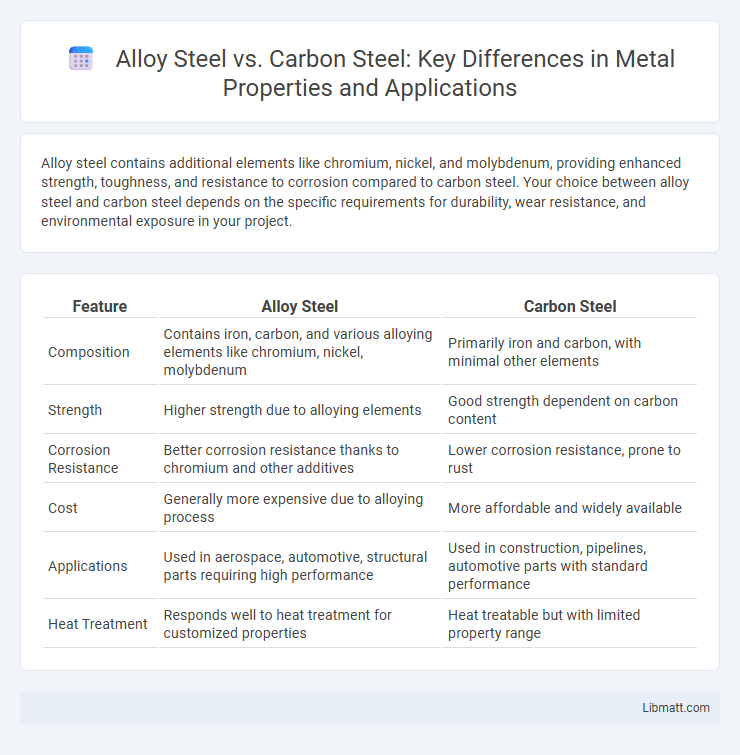Alloy steel contains additional elements like chromium, nickel, and molybdenum, providing enhanced strength, toughness, and resistance to corrosion compared to carbon steel. Your choice between alloy steel and carbon steel depends on the specific requirements for durability, wear resistance, and environmental exposure in your project.
Table of Comparison
| Feature | Alloy Steel | Carbon Steel |
|---|---|---|
| Composition | Contains iron, carbon, and various alloying elements like chromium, nickel, molybdenum | Primarily iron and carbon, with minimal other elements |
| Strength | Higher strength due to alloying elements | Good strength dependent on carbon content |
| Corrosion Resistance | Better corrosion resistance thanks to chromium and other additives | Lower corrosion resistance, prone to rust |
| Cost | Generally more expensive due to alloying process | More affordable and widely available |
| Applications | Used in aerospace, automotive, structural parts requiring high performance | Used in construction, pipelines, automotive parts with standard performance |
| Heat Treatment | Responds well to heat treatment for customized properties | Heat treatable but with limited property range |
Introduction to Alloy Steel and Carbon Steel
Alloy steel contains additional elements such as chromium, nickel, and molybdenum, which enhance its mechanical properties and corrosion resistance compared to carbon steel. Carbon steel primarily consists of iron and carbon, offering high strength and affordability but limited resistance to wear and corrosion. Understanding these differences helps you choose the right material for applications requiring specific strength, durability, or environmental resistance.
Composition and Material Differences
Alloy steel contains additional alloying elements such as chromium, nickel, and molybdenum, which enhance its mechanical properties and corrosion resistance, while carbon steel primarily consists of iron and carbon with minimal alloying elements. The higher carbon content in carbon steel increases hardness and strength but reduces ductility compared to alloy steel. Understanding these composition differences allows you to choose the appropriate steel type based on the required strength, durability, and environmental conditions of your project.
Mechanical Properties Comparison
Alloy steel offers superior mechanical properties compared to carbon steel, including enhanced strength, hardness, and toughness, due to the presence of elements like chromium, nickel, and molybdenum. Carbon steel typically has higher carbon content, which provides good hardness but lower ductility and impact resistance than alloy steel. When selecting materials for applications demanding durability and resistance to wear, your choice should prioritize alloy steel for its balanced mechanical performance under stress.
Strength and Durability Factors
Alloy steel contains additional elements such as chromium, nickel, and molybdenum that enhance its strength and durability compared to carbon steel, which primarily relies on varying carbon content. The presence of these alloying elements improves resistance to wear, corrosion, and high temperatures, making alloy steel more suitable for demanding applications. Carbon steel offers good strength but is generally less durable under extreme conditions due to its lower alloy content and susceptibility to corrosion.
Corrosion Resistance Capabilities
Alloy steel generally exhibits superior corrosion resistance compared to carbon steel due to the presence of elements like chromium, nickel, and molybdenum that enhance its ability to withstand oxidation and chemical exposure. Carbon steel, primarily composed of iron and carbon, tends to corrode faster when exposed to moisture and corrosive environments unless it is coated or treated. The enhanced corrosion resistance of alloy steel makes it suitable for applications in harsh environments such as chemical processing, marine, and power generation industries.
Cost Implications and Availability
Alloy steel generally costs more than carbon steel due to the inclusion of additional alloying elements like chromium, nickel, and vanadium, which enhance performance but increase material and processing expenses. Carbon steel is more widely available and produced in larger quantities, resulting in lower prices and easier procurement for general manufacturing applications. When balancing budget constraints and material performance, carbon steel offers a cost-effective solution while alloy steel provides superior mechanical properties for specialized uses.
Common Applications and Uses
Alloy steel is commonly used in aerospace, automotive, and power generation industries due to its enhanced strength, toughness, and resistance to wear and corrosion. Carbon steel finds extensive application in construction, pipelines, and manufacturing of structural components where high strength and affordability are critical. Both materials serve crucial roles in engineering projects, with alloy steel preferred for demanding environments and carbon steel for cost-effective structural purposes.
Weldability and Workability
Alloy steel generally offers better weldability than carbon steel due to its controlled chemical composition and reduced carbon content, minimizing cracking risks during welding. Workability in alloy steel varies based on alloying elements, but certain types can be less ductile and harder to machine compared to carbon steel, which typically exhibits higher workability and easier forming characteristics. Proper welding techniques and preheating may be necessary for alloy steel to maintain joint integrity and mechanical properties.
Maintenance and Longevity Considerations
Alloy steel generally offers superior corrosion resistance and durability compared to carbon steel, reducing maintenance frequency and extending the lifespan of your equipment. Carbon steel tends to require more frequent inspections and protective coatings to prevent rust and wear over time. Selecting alloy steel can lead to lower maintenance costs and improved longevity in demanding environments.
Choosing the Right Steel for Your Project
Selecting the right steel for your project depends on the specific application requirements such as strength, durability, and corrosion resistance. Alloy steel, enriched with elements like chromium and nickel, offers enhanced mechanical properties and resistance to wear, making it ideal for high-stress environments. Carbon steel, with varying carbon content, provides cost-effective strength and hardness suitable for construction and manufacturing tasks where extreme conditions are less critical.
Alloy Steel vs Carbon Steel Infographic

 libmatt.com
libmatt.com